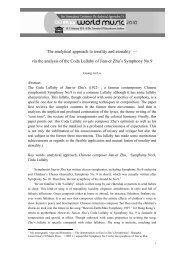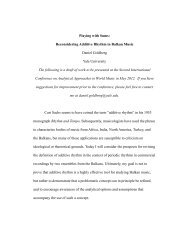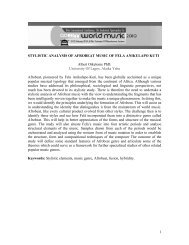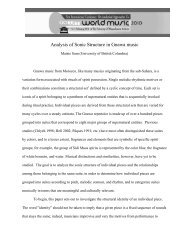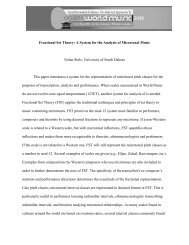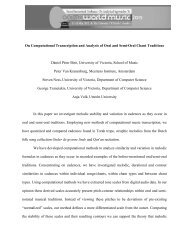Are genres really out there in the world, or are they merelyconstructions <strong>of</strong> analysts? Is there a finite taxonomy <strong>of</strong>genres or are genres timeless pla<strong>to</strong>nic essences orephemeral, time-bound entities? Are genres culture-boundor trans-cultural? Should genre analysis be proscriptive ordefinitive? (Stam 2004:14)Supporting Stam’s position above, Feuer (1992:144) submits that “ a genre is ultimatelyan abstract conception rather than something that exists empirically in the world”.Chandler (1997) also sees genre classification as a ‘theoretical minefield’, while Neale(1995:464) argues that “Genres are his<strong>to</strong>rically relative and therefore his<strong>to</strong>ricallyspecific”.Going by Neale’s submission above, frequent references by practitioners andpatrons <strong>of</strong> <strong>Highlife</strong> music <strong>to</strong> ‘the good old days’ <strong>of</strong> <strong>Highlife</strong>, may suggest that <strong>Highlife</strong>music is a product <strong>of</strong> a his<strong>to</strong>rical past. When viewed from this perspective, revivalprojects <strong>of</strong> E.T. Mensah <strong>of</strong> Ghana and Nigeria’s Vic<strong>to</strong>r Olaiya in 1983 in Lagos, theBAPMAF/Goethe Institut ‘<strong>Highlife</strong> Month’ held in Accra in February 1996, the GoetheInstitut ‘<strong>Highlife</strong> Party’ held in Lagos in 1998 and 1999 and the current monthly <strong>Highlife</strong>‘Elders’ Forum’ at the Ojez Nightclub in Lagos, may just represent at best, revivals <strong>of</strong> afading tradition. Yet, there are contemporary modes <strong>of</strong> <strong>Highlife</strong> expressions as seen in themusic <strong>of</strong> Chris Hanen <strong>of</strong> Ozigizaga fame, Bright Chimezie, Sunny Ineji, Lagbaja, JesseKing’s and many others in Nigeria; the ‘Burger’ and ‘Hip Life’ styles <strong>of</strong> C.K. Mann,Daddy Lumba, Nana Kyeame, Batman Samini and several other musicians and bandsplaying similar styles in Ghana. But whether old musicians and patrons <strong>of</strong> Nigerian andGhanaian <strong>Highlife</strong> music accept these contemporary modes as belonging <strong>to</strong> the <strong>Highlife</strong>category is another issue. For example, while watching a live performance <strong>of</strong>contemporary Nigerian musician, Sunny Ineji in Abuja Nigeria, the late veteran <strong>of</strong><strong>Highlife</strong>, Chief Osita Osadebe commented: “ they want <strong>to</strong> convert <strong>Highlife</strong> and play it aspop music but it will never work. <strong>Highlife</strong> is <strong>Highlife</strong>” 2 Osadebe’s comment and positionhighlights the growing generational gap between ‘old’ and ‘new’ Nigerian/Ghanaianmusicians. This is why it is important <strong>to</strong> adopt a his<strong>to</strong>rical and contemporary approach inthe study <strong>of</strong> <strong>Highlife</strong> music both in Ghana and Nigeria.However, as Miller has rightly observed, “ the number <strong>of</strong> genres in any societydepends on the complexity and diversity <strong>of</strong> that society” (Miller, 1984). Thus the ethnic10
complexity and cultural diversity <strong>of</strong> the West African sub-region must be taken in<strong>to</strong>account in our classification <strong>of</strong> musical genres and in determining the rules <strong>of</strong> inclusionin and exclusion from the <strong>Highlife</strong> category. This is why Gledhill (1985:64) submits that“ genres are not discrete systems consisting <strong>of</strong> a fixed number <strong>of</strong> listable items”, whileNeale (1980:48) is <strong>of</strong> the opinion that “genres are instances <strong>of</strong> repetition and difference”.Despite inherent problems in genre classification some <strong>of</strong> which have been discussedabove, it is necessary <strong>to</strong> still classify creative works according <strong>to</strong> certain criteria so thatgenres do not exist as formless and amorphous entities which will preclude interpretationand analysis.The Concept <strong>of</strong> Change and Genre DevelopmentChange as a concept has been defined by Jick & Peiperl (2003:xvi) as a “plannedor unplanned response <strong>to</strong> pressures and forces and I agree with him largely. The global‘soundscape’ <strong>of</strong> the 21 st century with its avalanche <strong>of</strong> economic, technological, musical,social, political and ideological changes have created several layers <strong>of</strong> pressures, choicesand survival strategies. From the graphic his<strong>to</strong>rical development <strong>of</strong> <strong>Highlife</strong> music earlieron, we can see that the development <strong>of</strong> the <strong>Highlife</strong> genre has been characterized bychanges which define the genre in specific social and musical terms synchronically andcontextually. We are also able <strong>to</strong> understand <strong>to</strong> some extent, the dynamics <strong>of</strong> musicalchange and responses <strong>to</strong> such changes in contemporary Africa. However, <strong>to</strong> manage thesechanges and put them in proper theoretical perspectives, I will deploy three perspectives<strong>of</strong> change developed by Linda Ackerman 3 , a business management expert. The modelswill help us <strong>to</strong> analyze these changes and <strong>to</strong> also assess how best they can serve asanalytical <strong>to</strong>ols for musical change and genre development.Fig. 1a Developmental ChangeInvolves continuousimprovement <strong>of</strong> what is11



